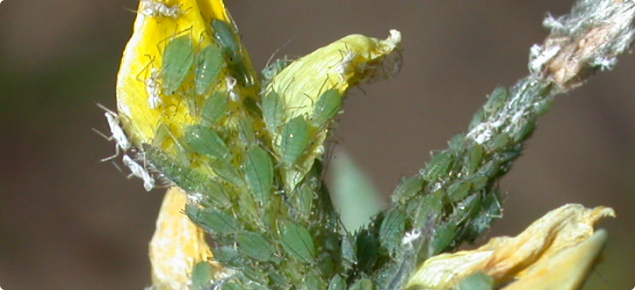Species that attack lupins
All five species of aphids found on lupins in Western Australia are introduced. The three most common species are
- cowpea aphid (Aphis craccivora)
- bluegreen aphid (Acyrthosiphon kondoi)
- green peach aphid (Myzus persicae)
Two other minor species sporadically recorded on lupin are:
- leafcurl plum aphid (Brachycaudus helychrisi)
- potato aphid (Macrosiphum euphorbiae)
This page pertains to the three common aphid species, which often occur together in a lupin paddock.
For information on aphid control and virus management refer to 'See also' section.
Cowpea aphid (CPA)

Description
The cowpea aphid has a black body and black and white legs. It tends to arrive in lupin crops earlier than green peach or bluegreen aphids. They often form dense colonies on a single plant before moving on to surrounding plants and the contrast of their black bodies against green plants make them very visible. Heavy colonisation can cause rapid wilting.
Host range
The cowpea aphid's host range includes pasture medics, faba beans and tree lucerne.
Bluegreen aphid (BGA)

Description
The bluegreen aphid is the largest of the three common species, measuring up to 3mm long. Both the winged and wingless forms are a matt bluish-green, similar in colour to the mature leaves of narrow-leaf lupins. The winged form has a light beige thorax.
Host range
This species prefers to feed on legumes and is a common pest of medic and sub-clover pastures. Large numbers of winged BGA fly from pastures to lupin crops later in the growing season. This species builds up to heavy colonies throughout the crop on susceptible lupin varieties.
Green peach aphid (GPA)
Description
The green peach aphid tends to be shiny or waxy and ranges from yellow, through to green and pink. The yellowy-green forms are similar in colour to young unfurled lupin leaves. The winged forms have a dark patch on their backs.
GPA tends to be evenly distributed throughout the lupin crop, unlike cowpea aphid, which has a patchy distribution. The size of their colonies are usually smaller than those of BGA and CPA.
Host range
GPA colonises a wide host range and are often found on a variety of weeds including wild radish, wild turnip, doublegee and blackberry nightshade. When selecting a suitable chemical to use against an aphid infestation that is mainly GPA, the grower should be aware that some populations of this species have developed resistance to chemicals.
Aphid survival between growing seasons
The timing of first aphid arrival (migration) during the growing season largely depends on availability of green plant hosts during the preceding summer and autumn. Small numbers of aphids can survive the hot dry conditions experienced during summer if their host plants are available. Rainfall in late summer and early autumn encourages survival of aphid host plant material, leading to early aphid flights into crops soon after seeding.

